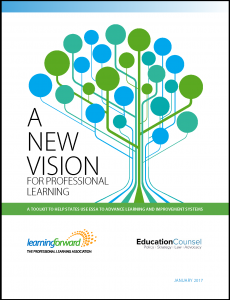
Learning Forward Advocacy
Events are unfolding rapidly. Stay tuned to this advocacy page for the latest information.
On March 20, President Trump signed an Executive Order calling for the closure of the U.S. Education Department and mandating that all federal programs comply with his other policies on DEI and gender ideology. While the White House had indicated that the Executive Order would not really be about closing the Department, suggesting that it would be more about reducing the Department and maintaining focus on core functions like Title I, IDEA, Pell, Student loans and Civil Rights compliance, the final document does call for “closing the Department of Education…to the maximum extent appropriate and permitted by law.”
At the signing ceremony, Trump seemed to acknowledge that it would take Congress to actually close the Department. Shortly after the EO was released, HELP Committee Chairman Bill Cassidy, R-LA, announced that he would be introducing legislation to close the Department.
Here are key portions of the EO:
Sec. 2. Closing the Department of Education and Returning Authority to the States. (a) The Secretary of Education shall, to the maximum extent appropriate and permitted by law, take all necessary steps to facilitate the closure of the Department of Education and return authority over education to the States and local communities while ensuring the effective and uninterrupted delivery of services, programs, and benefits on which Americans rely.
(b) Consistent with the Department of Education’s authorities, the Secretary of Education shall ensure that the allocation of any Federal Department of Education funds is subject to rigorous compliance with Federal law and Administration policy, including the requirement that any program or activity receiving Federal assistance terminate illegal discrimination obscured under the label “diversity, equity, and inclusion” or similar terms and programs promoting gender ideology.
Learning Forward issued a statement on the actions voicing concern about negative impact on valuable federal programs that improve teaching and learning nationwide.
House Appropriations Committee approves FY 2025 ed funding bill by 31-25 vote
U.S. House of Representatives Subcommittee Slashes Federal Education Budget
Join the Learning Forward A-Team in 2025 for regular policy updates
The Learning Forward Advocacy Team is your trusted source for news and updates on federal education policy, particularly the latest news on Title II-A. Signing up for the A-Team will ensure that you receive:
- Access to the latest education policy news through email updates
- An invitation to join a monthly 30-minute Zoom call for a federal update with opportunity to get your specific questions answered (2nd Tuesday of every month at 5 p.m. ET)
- Counsel on local and state policy needs from Learning Forward’s policy team
Sign up today using this link. No advocacy experience required – just information. Stay informed. Join the A-Team today.
Learning Forward Advocacy
Powered by Title II
Communities & members
Resources
Video: How is professional learning important for students?
Call to action: Save Title II-A
Now is not the time to be complacent. We need to remain vigilant in our efforts to save Title II-A. If you are reading this message, please take a moment to send a message to your members of Congress.

Learning Forward’s Powered by Title II campaign website puts all of the information, tools, and advocacy tutorials in one easy to access online location to enable educator advocates reach their Members of Congress and help convince them to support more Title II funding. On this site, advocates will find:
- The latest news on Title II
- Background facts, stories, research, and data on Title II
- A storytelling tool to assist you in researching and explaining how Title II supports your school district
- Sample letters, talking points, tweets and more to support your advocacy
Evidence, evidence, evidence
Evidence of impact is not optional. From your ESSA plans to Title II to talking with your district superintendent, everyone wants to know when professional development is making an impact and how you know. Learning Forward is here to help. We invite you to join your peers from across the U.S. to share your successes here.
Tell us what Title II funds in your school or district, and most important, what outcomes you see as a result. Outcomes might include improved graduation rates or assessment scores, improvements for specific populations of students, or other indicators that students are experiencing more meaningful learning.
This webinar, originally created for our Virtual Advocacy Day, includes advocacy strategies and tips that are applicable to any advocacy effort. Watch to hone your skills, build confidence, and get excited about being an advocate.
ESSA Toolkits
 A New Vision For Professional Learning: A Toolkit to Help
A New Vision For Professional Learning: A Toolkit to Help
States Use ESSA to Advance Learning and ImprovementSystems. This toolkit helps leaders leverage professional learning as
an essential tool in overcoming systemic inequities and guaranteeing
excellence for all.
Agents for Learning Toolkit: A Guide to Amplifying Teacher
Voice and Stakeholder Engagement. This toolkit suggests ways to cultivate teacher voice and agency in policy decisions and the implementation of professional learning.


